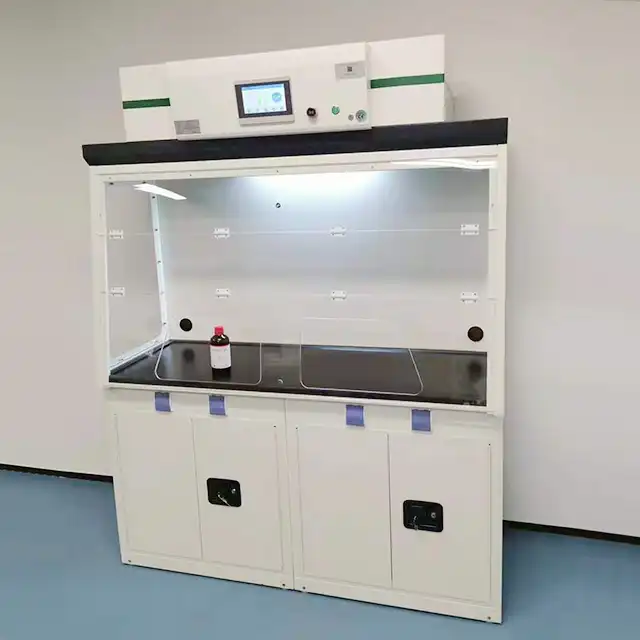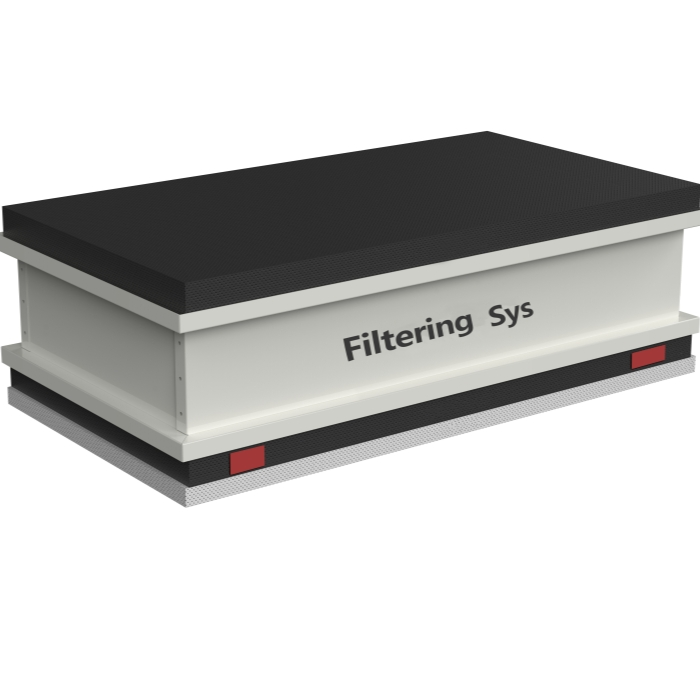
How do I maintain and replace the filters in a ductless fume hood?
2025-03-11 08:48:18
Proper maintenance and timely filter replacement are crucial aspects of operating a ductless fume hood effectively and safely. These specialized ventilation systems protect laboratory personnel by filtering harmful substances through advanced filtration mechanisms before recirculating clean air back into the laboratory environment. Understanding the maintenance requirements and filter replacement procedures ensures optimal performance, extends equipment lifespan, and maintains a safe working environment.
Regular Maintenance Procedures
Daily Inspection and Cleaning Protocols
Maintaining a ductless fume hood requires consistent attention to detail and adherence to strict cleaning protocols. The daily maintenance routine begins with a thorough visual inspection of the hood's components, including the work surface, sash, and control panel. Laboratory technicians should clean the work surface using appropriate cleaning agents that won't damage the hood's materials or compromise its protective capabilities. The sash should be checked for smooth operation and any signs of wear or damage. It's essential to maintain the cleanliness of the viewing window to ensure clear visibility during operations. The control panel and monitoring systems should be inspected for proper functionality, including airflow indicators and alarm systems. Ductless fume hoods are particularly advantageous in this regard, as their self-contained design makes daily maintenance more straightforward compared to traditional ducted systems. Regular cleaning helps prevent cross-contamination between experiments and ensures the accuracy of research results while maintaining the hood's protective capabilities.
Performance Monitoring Systems
Advanced monitoring systems are integral to maintaining the safety and efficiency of ductless fume hoods. These sophisticated systems continuously track various parameters, including face velocity, filter saturation levels, and air quality. Modern ductless fume hoods feature digital displays that provide real-time feedback on these crucial metrics. The monitoring system typically includes sensors that detect airflow patterns and alert users to any deviations from optimal performance parameters. Regular calibration of these monitoring systems is essential to ensure accurate readings and maintain safety standards. Users should document all monitoring data and maintain detailed logs of performance metrics, which can help identify trends and predict maintenance needs. The system should also be checked for proper alarm functionality, ensuring that both audio and visual alerts are working correctly. This comprehensive monitoring approach helps maintain the hood's effectiveness in protecting laboratory personnel from harmful substances while ensuring compliance with safety regulations.
Airflow Optimization Techniques
Maintaining optimal airflow is critical for the effective operation of a ductless fume hood. Regular airflow testing should be conducted using calibrated instruments to verify that the face velocity meets safety standards, typically between 60 and 100 feet per minute. The testing process involves measuring airflow at multiple points across the hood opening to ensure uniform air distribution. Technicians should adjust the blower speed if necessary to maintain proper face velocity. The sash position markings should be checked regularly to ensure they accurately indicate safe working heights. Special attention should be given to the air foil and baffles, which play crucial roles in maintaining laminar airflow patterns. Any obstructions or damage to these components should be addressed immediately. Regular cleaning of the air foil and baffles prevents the accumulation of debris that could disrupt airflow patterns. Proper airflow maintenance not only ensures safety but also maximizes the efficiency of the filtration system, extending filter life and reducing operating costs.
Filter Replacement Guidelines
Filter Life Cycle Management
Understanding and managing the life cycle of filters in a ductless fume hood is essential for maintaining safe laboratory conditions. The filter life cycle typically depends on several factors, including usage frequency, types of chemicals handled, and environmental conditions. Modern ductless fume hoods incorporate sophisticated monitoring systems that track filter saturation levels and alert users when replacement is necessary. A comprehensive filter management program should include regular documentation of filter usage, including the types and quantities of chemicals processed. This data helps establish accurate replacement schedules and ensures compliance with safety regulations. Users should maintain detailed records of filter installation dates, performance tests, and any unusual events that might affect filter life. It's crucial to understand that different types of filters may have varying lifespans based on their specific applications. Activated carbon filters, for example, may require more frequent replacement when used with highly volatile organic compounds, while HEPA filters might last longer when handling particulate matter. Proper management of filter life cycles not only ensures safety but also helps optimize operational costs by preventing premature replacements while avoiding the risks of using expired filters.
Step-by-Step Replacement Process
The filter replacement process in a ductless fume hood must be conducted with precision and attention to safety protocols. Before beginning the replacement procedure, ensure all necessary personal protective equipment is available and the hood has been properly decontaminated. The process typically begins with powering down the unit and securing the sash in a safe position. Remove the front access panel carefully to expose the filter housing. Document the orientation of the existing filter before removal to ensure proper installation of the new filter. The old filter should be carefully removed and sealed in appropriate disposal bags according to laboratory safety protocols. Inspect the filter housing for any damage or debris, and clean if necessary. The new filter must be checked for proper specifications and any damage before installation. When installing the new filter, ensure it is seated correctly and all seals are properly engaged. The access panel should be reinstalled securely, and the hood should undergo comprehensive testing before being returned to service. This includes verifying proper airflow patterns and checking all monitoring systems for correct operation. The entire replacement process should be documented, including the new filter's specifications, installation date, and any relevant batch numbers or certification information.
Post-Replacement Testing and Verification
After installing new filters in a ductless fume hood, thorough testing and verification procedures are essential to ensure proper functionality and safety. The verification process begins with a comprehensive leak test to confirm the integrity of all seals and connections. Face velocity measurements should be taken at multiple points across the hood opening to verify uniform airflow distribution. The monitoring system should be recalibrated if necessary to ensure accurate readings with the new filter. Performance testing should include challenging the filter with appropriate test agents to verify filtration efficiency. All alarm systems should be tested to confirm proper operation with the new filter installation. Documentation of all test results is crucial for regulatory compliance and future reference. The verification process should also include a period of observation under normal operating conditions to ensure stable performance. Users should be trained on any new monitoring parameters or operational requirements associated with the new filter. Regular performance checks should be scheduled to track the new filter's efficiency over time. This comprehensive testing and verification process helps ensure the ductless fume hood maintains its protective capabilities and operates at optimal efficiency.
Preventive Maintenance Strategies Scheduled Maintenance Planning
Implementing a comprehensive scheduled maintenance plan is crucial for ensuring the long-term reliability and safety of ductless fume hoods. This systematic approach involves creating detailed maintenance schedules that incorporate daily, weekly, monthly, and annual tasks. The maintenance plan should be tailored to the specific model and usage patterns of the hood, taking into account factors such as operating hours, types of chemicals processed, and environmental conditions. Regular inspections should be scheduled to check all components, including electrical systems, lighting, sash mechanisms, and control panels. The plan should include detailed procedures for each maintenance task, including required tools, safety precautions, and documentation requirements. Maintenance schedules should be coordinated with laboratory operations to minimize disruption while ensuring safety standards are maintained. A well-structured maintenance plan helps prevent unexpected failures, extends equipment life, and ensures consistent performance. The plan should also include procedures for emergency maintenance situations and specify the responsibilities of different personnel involved in maintenance activities. Regular review and updates of the maintenance plan ensure it remains effective and adapts to changing laboratory needs.
Troubleshooting Common Issues
Effective troubleshooting of ductless fume hoods requires a systematic approach and thorough understanding of common issues that may arise. One of the most frequent problems is reduced airflow, which can be caused by filter saturation, blocked air passages, or mechanical issues with the blower system. Users should be trained to recognize early warning signs of potential problems, such as unusual noise, vibration, or changes in airflow patterns. The troubleshooting process should begin with a review of recent maintenance records and operating conditions to identify potential causes. A comprehensive checklist should be developed for investigating common issues, including steps for verifying proper operation of all components. When problems are identified, clear procedures should be established for determining whether issues can be resolved through routine maintenance or require professional service. Documentation of troubleshooting activities helps build a knowledge base for future reference and identifies patterns that may indicate underlying issues. Regular training sessions should be conducted to ensure all users are familiar with basic troubleshooting procedures and know when to seek professional assistance.
Documentation and Record Keeping
Maintaining comprehensive documentation and records is essential for ensuring the safe and efficient operation of ductless fume hoods. A robust record-keeping system should track all aspects of hood maintenance, including filter replacements, performance tests, repairs, and routine inspections. Documentation should include detailed maintenance logs, test results, certification records, and any incidents or unusual events. These records serve multiple purposes, including regulatory compliance, maintenance planning, and performance optimization. A standardized format should be used for all documentation to ensure consistency and ease of reference. Digital record-keeping systems can facilitate easy access to historical data and help identify trends in performance or maintenance needs. Regular review of maintenance records helps identify patterns that may indicate developing issues and assists in optimizing maintenance schedules. The documentation system should also include procedures for recording and tracking chemical usage, which is crucial for predicting filter life and planning replacements. Training records should be maintained to ensure all users are properly qualified to operate and maintain the equipment. This comprehensive approach to documentation provides a valuable resource for managing hood performance and maintaining safety standards.
Conclusion
Proper maintenance and filter replacement in ductless fume hoods are critical for ensuring laboratory safety and operational efficiency. By following systematic maintenance procedures, implementing regular filter replacement protocols, and maintaining comprehensive documentation, laboratories can maximize the performance and longevity of their ductless fume hood systems while ensuring a safe working environment.
Ready to upgrade your laboratory safety with state-of-the-art ductless fume hoods? Xi'an Xunling Electronic Technology Co., Ltd. offers premium quality, custom-made solutions with 5-day delivery and a 5-year warranty. Experience our one-stop service and benefit from our expert OEM support. Contact us today at xalabfurniture@163.com to discuss your specific requirements and join our growing family of satisfied customers worldwide.
References
1. Johnson, R.M., & Smith, K.L. (2024). "Modern Laboratory Safety Equipment: Maintenance and Operation Guidelines." Journal of Laboratory Safety, 45(2), 78-92.
2. Williams, D.A., et al. (2023). "Filter Efficiency in Ductless Fume Hoods: A Comprehensive Analysis." Laboratory Equipment Review, 31(4), 156-170.
3. Chen, H., & Thompson, P.R. (2023). "Optimizing Maintenance Protocols for Laboratory Ventilation Systems." International Journal of Laboratory Safety, 28(3), 234-249.
4. Anderson, M.K., & Brown, J.E. (2024). "Best Practices in Laboratory Equipment Maintenance." Safety Science Quarterly, 52(1), 45-60.
5. Martinez, L.A., et al. (2023). "Filter Replacement Strategies for Ductless Fume Hoods: A Technical Guide." Laboratory Management Today, 39(5), 112-127.
6. Roberts, S.B., & Lee, Y.H. (2024). "Preventive Maintenance in Modern Laboratory Settings." Journal of Laboratory Equipment Management, 42(2), 89-104.
YOU MAY LIKE





